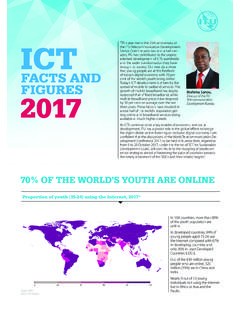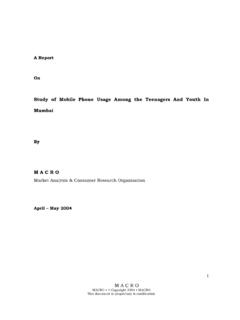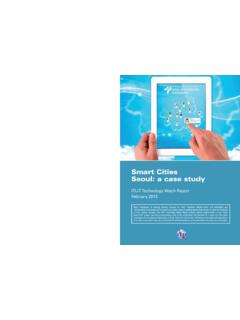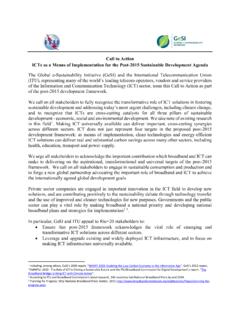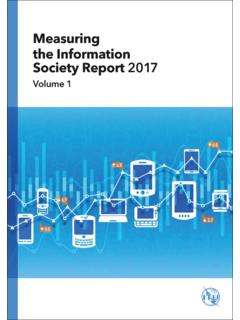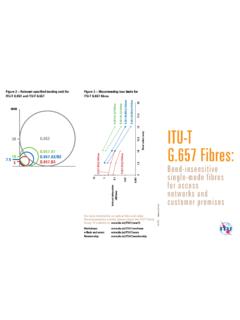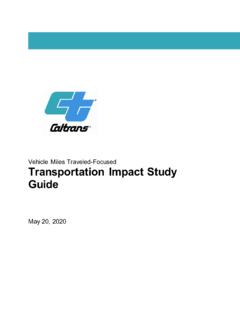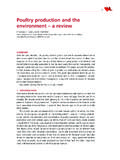Transcription of SOCIAL AND ECONOMIC IMPACT OF THE AUTOMATED …
1 GSR 17 Discussion paper SOCIAL AND ECONOMIC IMPACT OF DIGITAL TRANSFORMATION ON THE ECONOMY Work in progress, for discussion purposes Comments are welcome! Please send your comments on this paper at: by 30 July 2017 The views expressed in this paper are those of the author and do not necessarily reflect the opinions of ITU or its Membership. 2 This report was prepared by Raul L. Katz, ITU expert, under the direction of the ITU/BDT Regulatory and Market Environment Division. 3 CONTENTS Executive Summary .. 4 1. Framing the issue .. 6 2 Definition of digitization technology waves.
2 8 3. SOCIAL and ECONOMIC IMPACT of the first wave of digitization .. 14 IMPACT on ECONOMIC growth .. 14 IMPACT on job creation .. 15 IMPACT on SOCIAL welfare .. 16 4. SOCIAL and ECONOMIC IMPACT of the second wave of digitization .. 18 Business innovation as a driver of ECONOMIC growth .. 19 Labor force IMPACT .. 20 Elimination of jobs .. 20 Creation of jobs .. 21 Labor force polarization .. 22 Welfare IMPACT .. 23 Compilation of SOCIAL and ECONOMIC IMPACT of the second digitization wave .. 24 5 SOCIAL and ECONOMIC IMPACT of the third wave of digitization.
3 26 IMPACT on ECONOMIC growth .. 26 IMPACT on labor 28 IMPACT on SOCIAL welfare .. 29 6. Policy implications .. 30 Promoting innovation and addressing workforce disruption in developed countries .. 30 Promoting Innovation and addressing workforce disruption in emerging economies .. 32 7. Conclusion .. 34 BIBLIOGRAPHY .. 37 4 Executive Summary Digitization refers to the transformations triggered by the massive adoption of digital technologies that generate, process, share and transfer information. Digital transformation is not a one time event.
4 It proceeds in waves driven by technological progress and diffusion of innovations. The first wave of digitization is associated with the introduction and adoption of what today are considered mature technologies, such as management information systems aimed at automating data processing and applied to monitoring and reporting of business performance, telecommunications technologies such as broadband (fixed and mobile) and voice telecommunications (fixed and mobile) which allow the remote access of information. The second wave of digitization entails the diffusion of the Internet and its corresponding platforms (search engines, marketplaces), which enable the networking of enterprises to consumers and enterprises among themselves for purchasing of supplies, and distribution of output.
5 The third wave of digitization entails the adoption of a range of advanced technologies, such as big data/analytics, Internet of Things, robotics, sensors, and artificial intelligence, and is aimed at enhancing information processing and the quality of decision making, while further automating routine tasks within business enterprises and governments. These technologies are not typically adopted in a stand alone fashion but are integrated with the mature technologies characteristic of the first and second waves. Each digitization wave has a specific set of SOCIAL and ECONOMIC impacts.
6 Computing, broadband and mobile telephony networks have been instrumental in relaxing industry scalability constraints, thereby allowing traditional sectors of the economy to grow more rapidly. The alleviation of the resource constraint has led to increased demand for labor in service industries, ( , financial services, education, health care, etc.) although it also had a positive effect in manufacturing. Finally, the first wave appears to have had an IMPACT on the growth of household income, and the facilitation of SOCIAL inclusion (access to information, government services, and entertainment content).
7 The second wave of digitization has led to the introduction of new services and applications such as Internet information searches, electronic commerce, distance education and a whole range of collaborative businesses that characterize the digital economy (Uber, airbnb, etc.). This innovation effect has yielded enhanced demand for labor in certain occupations linked to the development of digital services or the emergence of collaborative business models, coupled with the disappearance of repetitive low and middle skilled jobs resulting from task automation.
8 The third wave of digitization has significant implications for productivity improvements. It also promises to have significant benefits on SOCIAL welfare, more particularly on several Sustainable Development Goals, associated with the delivery of public services. The 5evidence so far with regards to the disruptive labor effects of the third wave are quite speculative, unless once believes that third wave disruption is merely an extrapolation of the second digitization wave effects. However, there is almost universal agreement that, similarly to the prior waves of innovation, automation will tend to favor those workers with more education and training.
9 In this context, it is relevant to consider the policy remedies that could propel the benefits of automation and limit the negative outcomes: Implement labor market policies focused on workers being able to either retain their current jobs or move to the new areas of demand. These policies comprise job placement services, special labor market programs and wage subsidies to lessen the transition cost; Deploy policies focused on increasing geographic mobility, which would allow workers residing in areas affected by automation to move to high job creation cities.
10 Accelerate the creation of clusters of industries and universities around high quality of life locations that stimulate high skilled labor demand in under developed areas. In particular, emerging countries need to actively promote the digitization of production and digital transformation. This requires emphasizing policies focused on accelerating the digitization of production of small and medium enterprises, by reducing the cost of technology acquisition, training of employees, and the provision of consultancy services to support companies in their process of digital transformation.
